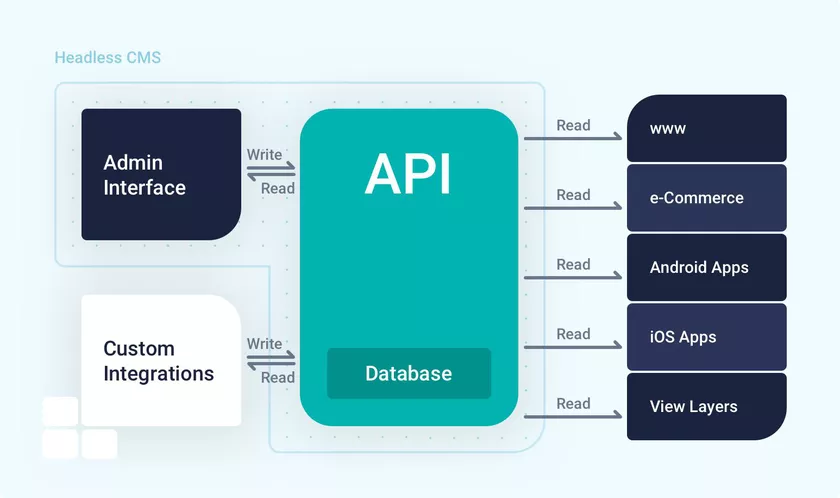Headless CMS for Content Management
How content management is becoming a growth driver for brands and where headless CMS can help
The importance of digital channels for brands is undisputed. If a company wants to turn users into customers in this environment, it has to offer much more than simple products or lurid purchase offers. The key is digital experiences that move users, bind them emotionally to a brand, and thus contribute significantly to the growth of brands. Innovative technologies can be a key driver here – also in the area of content management.
If you believe the “20-2-20” rule, companies have to be on their toes when it comes to attracting customers online. To convert a lead into a conversion, companies have exactly 20 seconds from the time of the website visit to attract attention. Then two minutes to stimulate engagement and finally 20 minutes to build a relationship with the customer.
But what criteria must a website fulfill in order to convince an unfamiliar user in just 20 seconds so that he or she actually buys in the end? There are many reasons for this, but technical factors such as short loading times and a clear page layout are crucial, in addition to compelling content and a strong design. In fact, it’s not only the front end that determines success in reaching customers, but also a smoothly functioning back end.
A contemporary technology solution that takes both levels into account are content management systems that work according to the headless principle.
Index
How does a headless CMS work
The term headless content management system, or headless CMS for short, usually refers to back-end content management systems that are structured as content repositories and make content accessible for display on any end device via specific interfaces – RESTful APIs or GraphQL APIs. The term “headless” means: the “head” as the front end in the form of the website is separated from the “body”, the back end (content repository).
The counterpart to a headless content management system is often referred to as a monolithic, regular or coupled CMS. Thus, a headless CMS does not care about what content is displayed where. Rather, the approach ensures that developers can develop and deploy a flexible framework for digital experiences, and content editors can bring that framework to life with stories quickly and efficiently.
In practice, this means that developers create flexible components that content teams can manage independently using a visual editor and customizable workflows. Compared to monolithic systems, content that has been edited once can thus be played out across all channels: on websites, mobile, in IoT and AR/VR applications, and on all other platforms.

What are the advantages of a headless CMS?
Since a headless CMS separates the head from its technology stack, developers are not tied to a specific backend and can flexibly and individually program the entire website based on the provided REST or GraphQL APIs. This approach also allows developers to work with technology solutions they are already familiar with.
Instead of having to learn a new, monolithic CMS from scratch – including all the technical challenges – developers have more time to optimize a website for technical factors such as pagespeed and webvitals. In addition, a headless CMS offers the advantage of relaunching parts of a website or implementing a new tech solution at a specific point without affecting other areas.
| Monolithic CMS |
Headless CMS |
|
| Platform independence | nein | ja |
| Exchangeable technology stack | nein | ja |
| Omnichannel-Unterstützung | nein | ja |
| API-first approach | nein | ja |
| “Plugin Apocalypse” | ja | nein |
| Localization | ja | ja |
| Code maintainability | nein | ja |
How do brands and consumers benefit?
More than ever, customers are demanding unique, sophisticated digital experiences from brands. A headless CMS enables developers, marketers, and content managers to easily and intuitively create digital content in the form of individual content blocks – once for all platforms on which a brand is present. All in the spirit of an “omnichannel experience.” So a headless CMS is not limited to websites, but includes all other channels in which a user:in comes into contact with a brand.
Undoubtedly, the right CMS can act as a growth driver for businesses. Let’s take the example of internationalization: While with a traditional CMS a separate website with its own code has to be created for each target market, content can be published in multiple languages via one and the same headless backend. Content can be published in multiple languages. This way, brands massively reduce maintenance efforts and make their content management much more efficient.
When is it worth using a headless CMS?
A “headless” setup is particularly suitable for companies that want to strengthen the digital visibility of their brand. In addition, headless systems are predestined as a basis for websites with high traffic and many transactions or those with a large volume of content as well as complex management requirements. Companies can also use the time they save with a headless CMS versus a monolithic CMS to focus on content and create exceptional brand experiences.
Companies pursue different goals with their online strategy, which is why the question of the right CMS cannot be answered in a blanket manner. One thing is clear: the headless approach offers companies ideal conditions for being present in more than just one digital channel – and thus maintaining the opportunity to inspire their customers and all those who are to become customers with the right content at the ideal touchpoint in each case.

Comments are closed.